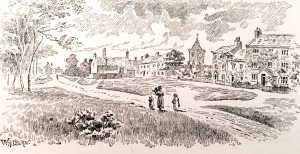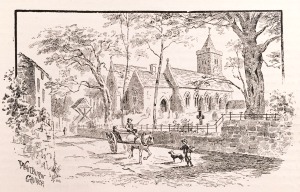Many pleasant and interesting communities are to be found on our rocky North-East Coast; but few, if any, surpass the peaceful little village of Whitburn, situated between South Shields and Sunderland.
Whitburn might be said to have a double claim on the attention of the wayfarer who may pay it a visit. Its position on the coast renders it a desirable retreat for a summer holiday, while the village itself has an air of delightful rusticity about it which cannot fail to fascinate and charm. As we approach the east end of the village, the sobbing of the waves is heard as they beat against the rocks, licking the sandy beach in their course, while the marine prospect which greets the eye is of course of an attractive nature. The west end of the village presents a widely different aspect. No glimpse of the sea is to be had here, and its murmuring is inaudible to the ear. The eye alights, instead, upon a scene of real rural beauty. The whole neighbourhood is flooded with the melodies of
The meadow-lark and all the throng
That dwell in nests and have the gift of song.
It is this rather unusual combination of attractions the arcadian and the marine that constitutes Whitburn’s greatest charm.
Our view of Whitburn shows the quaintest and most interesting part of the village. The artist’s coign of vantage is in close proximity to the end of the road leading into Whitburn from South Shields and Cleadon. Some of the dwellings are white-washed structures, with an air of cleanliness about them which greatly adds to their quaint and interesting appearance. The fronts of the larger houses are covered with ivy, and here and there the view is made prettier by the presence of trees towering in many cases far above the eaves of the dwellings. But what makes this part of Whitburn specially fascinating to lovers of the picturesque are the uncommonly large strips of green on either side of the main road through the village. Indeed, what with grass and trees, the village in the leafy period presents quite an arcadian appearance. As we walk towards the east and more modern part of the village, the large residences on the left, with their fronts of artistic wood-work, and the trim, sloping lawn skirted with a line of stately trees, form a very pretty picture indeed.
Having taken our fill of the many attractions which a ramble through the village street affords, we proceed down the shady lane leading to the church. Whitburn Church is an old Gothic edifice, consisting of a nave and two regular aisles, each being formed by four round pillars. The chancel is separated from the nave by a wide pointed arch. The sacred structure, embosomed as it is in trees and shrubs, presents a truly neat appearance; and, as has been said respecting it, however the antiquary may deplore the raftered roof and the dim mullioned windows, it must be allowed that Whitburn is the the exemplar nitidiss of a comfortable parish church. The churchyard, though not by any means large, is as neat in appearance as the church itself. The graves are well tended, many being covered with flowers of every hue and description. Several of the ancestors of Sir Hedworth Williamson, formerly member of Parliament for North Durham, are buried in Whitburn churchyard.
In 1675 Whitburn rectory was enlarged and new fronted by Dr. Musgrave (“with £140 dilapidations received from his predecessor Speed”). The new rooms were added to the east of the late rectory in 1770 by Dr. Pye at an expense of £400. The same gentleman repaired the houses, barns, and offices. He took no money from his predecessor for dilapidation, however, excepting, as the historian says, “£5 worth of fixtures.” In 1816 the rectory was demolished, and in its place was erected a new parsonage built of freestone.
One of the rectors of Whitburn parish was the Rev. Thomas Triplet, M.A., who ministered from 1631 to 1662. During the Rebellion, he was ejected; but, after the Restoration, he was made prebendary of Westminster and D.D. He bequeathed £300 to the parishes of Woodhorn, Washington, and Whitburn, the interest of which sum he directed to be equally divided every year for the purpose of binding poor children apprentices.
Leaving the church, we make towards the little hamlet on the beach, known as The Bents; but not before we have had a peep at Whitburn Hall, the seat of Sir Hedworth Williamson. The Whitburn Cricket Club is indebted to Sir Hedworth for their ground, which is in juxtaposition to the hall. And splendid ground it is for cricketing purposes. The large stretch of sward is well rolled, and the trees and shrubs almost surrounding it render the place pleasing to the eye. Though Whitburn is known to be a fishing village, its palmy days are apparently almost over. At one time, so a fisherman at The Bents told us, the village possessed fourteen fishing boats; now, however, there are only about five; and whereas about forty-six persons earned their living by fishing in former years, the number at present so employed may be estimated at little over twenty.
The fine stretch of sandy beach extending from The Bents to Roker, is undoubtedly one of Whitburn’s principal attractions. Though the road leading to it is a little removed from the village proper, it is, as a matter of course, much frequented by visitors. Standing on the sward, a little to the south of The Bents, where the fishermen dry their nets, we note that the marine prospect is especially fine. The line of rocks away out to sea is known as Whitburn Steel once the scene of many shipwrecks. These were in some instances supposed to be caused by false lights which put vessels out of their course. Though strenuous efforts were made to solve the mystery surrounding the allegation, it remains a mystery to this day. But so numerous were the disasters that happened at the Steel that it was deemed absolutely necessary to replace the old lighthouse at Whitburn by the greatly improved lighthouse at Souter Point, which was accordingly erected in 1871. One of the present keepers of the lighthouse Mr. Robert Darling, formerly of the Coquet Island lighthouse is a nephew of the famous Grace Darling, and has occupied the position for eighteen years.
In November, 1822, part of a submarine forest was discovered about a mile to the south of Whitburn. On the removal of the sand one hundred yards seaward from high water mark, the stems of seven trees were brought to light. The largest of them is described as having been about six feet in diameter, and all were clearly in the situation in which they had grown. There was also a great quantity of vegetable matter leaves, nuts, and broken branches around the trees, and immediately below them a light blue clayey soil. From this discovery it would appear as if at some remote period what is now a sea beach was covered with vegetation.


Wonderful reading.
LikeLike
Very interesting read.Facts there i knew nothing about.Personally i think its the sweetest village for history.
We are very lucky living here.The Sea being our coastal gem.
Good people around us too..full of their own stories..past and present .
LikeLike